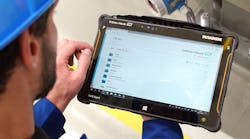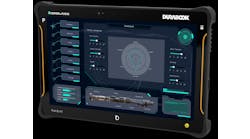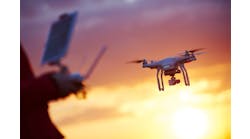Because most users are even more pressed for time now than they were before COVID-19, several suppliers are bundling multiple software packages and other tools into unified platforms and strategies that are faster and easier to implement and operate, and offering their perspectives on the pandemic and how process industries and users can cope with it.
Beckhoff
"Mobile technologies for dealing with the impacts of COVID-19 already exist. We just need more motivation and demonstrated payback to increase use of mobility technology, but generally, industrial sectors such as the process industries are conservative and slow to adapt to them," says Daymon Thompson, national software product manager at Beckhoff USA. "There's no question the pandemic will fuel acceptance and adoption of remote operations, troubleshooting and predictive maintenance. I don't think we can go back to the old ways. Fortunately, innovative oil and gas operators have already implemented mobile technologies—for example, the ability to drive up close to pads or equipment and access them using tablets or PCs within a certain range. However, operators that were always in control rooms before, now have to split up into separate cubicles because of changes due to COVID-19. We're getting more inquiries about web-based visualization technologies, as well as virtual commissioning and testing, and code for building equipment simulations that can tie in the controls programs.
"For example, Simulink graphical programming from MathWorks can be used to build a plant model. That model can then talk directly to the control code, usually for virtual testing and verification, or driving control behaviors in the simulation model. Previously, only large plants did this, but now even small sub-assemblies can use software models for virtual commissioning, which helps when teams have to be spread out. If the COVID-19 pandemic had happened a few years or a decade earlier, it would have been far more devastating to industry because we didn't have these newer capabilities. Consequently, users are implementing full toolsets and tool-chains to remotely commission, monitor, maintain and update equipment, controls and firmware, including using models for designing and creating control algorithms."
To assist these and other user projects, Thompson reports that Beckhoff USA built an online training portal for several products, and continues to grow its training modules. "Users in every industry are seeking more methods to making remote connections and access their equipment. Whether that’s via virtual private networks (VPN) or the Internet through cloud-based services, they also need appropriate cybersecurity. Luckily, these capabilities are already built into Beckhoff's products, so we can connect to equipment and controllers, access PLC diagnostics from home, and access control engineering tools on our website, even via a mobile device."
Emerson Automation Solutions
"We already send push notifications to tablet PCs and smartphones with Plantweb Optics software, which can consolidate information from multiple systems and underlying sources," says Anna Velena, product manager for software interfaces at Emerson. "However, where it used to be merely nice to have, many users are demanding it, so they can alert coworkers that are not onsite.
"The same goes for augmented reality (AR), which used to be cool but unnecessary and now has experienced a huge spike in interest since the pandemic happened. It can enable access to sites and let users continue operations and protect personnel at the same time. Our internal staffers usually go to sites for testing, but now they're planning to use Plantweb Optics with AR to do factory acceptance tests (FAT) on hardware with remote experts online. They're also planning to use it offline, too, for digital procedures in a tablet PC or smartphone app, which users can upload later and help them follow the steps to take during a walkdown or other tasks."
Velena reports that implementing mobility and AR functions begins with an inventory of the user's underlying systems, critical instruments and other assets, and adding Plantweb Optics and its interfaces as needed.
Endress+Hauser
"Mobility is becoming more about visibility, and seeing a production asset just like someone who's right next to it," says Ben Myers, solutions and services product manager at Endress+Hauser. "These technologies are all growing more prevalent due to COVID-19, but many organizations weren't ready, were taken by surprise, and had to learn and adapt much faster than originally planned. We work daily with our Field Xpert tablets, RealWear headsets, mobile phones, and IIoT and cloud-based devices that are advancing quickly as well. We identify pain points for users, and try to alleviate them with remote solutions or greater visibility into processes. COVID-19 often means fewer staff and less collaboration onsite. However, everyone is learning to use online meeting tools and platforms for collaboration, and remote and augmented reality (AR) devices are enabling operators to point out what they're seeing and get training, too."
To help its customers adapt and adopt these new tools, Myers reports Endress+Hauser is setting up platforms on its Field Xpert SMT70 tablets, which include preloaded videos and other materials they can access for remote support and training at their own speed. It's also helping users make the case for training to their organizations by demonstrating its return on investment (ROI) and how it can reduce downtime and other costs. "We're showing users that previously called a technician, how to use a tablet with a cellular connection to reach an expert to get their issue fixed without someone traveling to it," explains Myers. "We're also demonstrating how to use an IIoT device like an FWR30 radar unit with a cloud connection to remotely monitor a storage tank's level and their inventory with a mobile software app. And, we're showing them how to use RealWear headsets to see processes, work with operators and maintenance technicians in real time, ensure safe processes, and call up manuals with voice commands. Because fewer people can go onsite to support technicians due to COVID-19, these solutions give back some peace of mind in these uncertain times."
Honeywell Process Solutions
"Consumer electronics and computing have been pushing the industrial space for awhile, but COVID-19 is highlighting this situation. For example, we can use global positioning down to about 2 feet using a local frequency, but Apple's iPhone 11 can do 50 cm," says Vincent Higgins, general manager of the Connected Worker program at Honeywell Process Solutions. "The pandemic is creating much more interest in mobility applied to people for contact tracing and body temperature monitoring, and collaborating over longer distances due to reduced onsite staffing. Positioning can show users where they are in relation to a gas leak and the nearest metering station, but it can also aggregate multiple data sources to improve decisions when fewer staff are available to carry out increasingly autonomous operations."
To enable these efforts, Higgins reports that Honeywell recently introduced its Experion Augmented Remote Operations (ARO) program, which is a prepackaged version of its remote operations capabilities that streamlines deployment, testing and certification of remote access points for control or monitoring from months to days. "Experion ARO lets remote users see graphical plant data, and alert operations if needed," says Higgins. "Because the pandemic is fueling visualization of field data and digitalized workflow, we're also seeing a big uptick in hands-free, wearable devices used for condition-based maintenance. For example, one early adopter of our Connected Worker solutions is Brasksem Idesa's plant in Nanchital, Veracruz, Mexico, which converts ethane to ethylene to produce more than 1 million tons of polyethylene per year. Its staff recently jumped past tablet PCs to use wearable devices to do their operations rounds, and replaced walkie-talkies with video chat to do equipment readings and consult with offsite experts." (A video about Braskem's application that Honeywell produced with the Wall Street Journal is located at https://www.youtube.com/watch?v=aypnYBd1sF8&feature=youtu.be)
In addition, Honeywell recently acquired Rebellion Photonics that provides real-time gas monitoring that visually identifies and quantifies gas releases to quickly detect and analyze leaks and keep workers safe. Its intelligent, self-calibrating monitoring system incorporates an AI-driven software platform that automatically alerts plant operators if a gas leak, fire or security issue is detected and provides detailed analytics. "Rebellion's thermal imaging technology is typically used for flare stack monitoring," explains Higgins. "However, it can also be used to check body temperatures and whether personal protective equipment (PPE) is being used correctly. Conversely, a lot of mobile technology used on the consumer side can be used on the industrial side, such as using Uber's locating capability for collaborative mapping. The key is to look at what technology gives you the most value, whether it's more efficient inspections or better collaboration and control in the field, and conduct a small pilot to prove it by aggregating data and insights."
mCloud
Brent Stanley, business development VP for Connected Industries at mCloud Technologies Corp., reports it focuses on connected worker solutions, and develops software applications for several platforms such as RealWear to get users the data and remote expert connections they need. Its flagship, subscription-based AssetCare platform brings field data to IIoT and cloud-based analytics programs, but it's supported by mCloud's LiveOps team of domain experts, who monitor its analytics for users. They identify trends that subscribers should pay attention to, and also focus on underserved assets, so they show value by heading off problems to avoid unplanned downtime. The software and team also use 3D scans and virtual reality models to support remote inspection, update their as-builts, and increase their efficiency with improved planning of work package and inspection programs. These models can include physical and/or operational digital twins or equipment simulations for advanced analytics and failure predictions.
"We watch instead of just giving users a dashboard," says Stanley. "Once we have asset information including physical data, we make it available to connected field staff and the experts guiding them. What we're doing now is more like virtual mobility. For example, one of our nuclear industry clients with a U.S. facility needed to get work done despite COVID-19, and wanted us to come into the field and scan its operations using laser-based, point-cloud technology. We planned where to scan in several locations, enabled the onsite staff to do it, and this allowed them to create a model that let them and their colleagues be virtually onsite."
Pat Kelly, process solutions director at mCloud, adds: "One of our clients in British Columbia recently commissioned a large turbo expander for gathering natural gas into pipelines, but the recent quarantine meant they couldn't fly in an expert like usual. We worked with them, used our Connected Worker solution to hear and see what they needed, and successfully commissioned this device from the U.S. People are used to doing tasks in certain ways, but COVID-19 is causing them to be more creative, and this is likely to be a step change that's carried into the future. We're trying new things like working at home, and it may mean that offices aren't as necessary in the future. More users are experimenting, but the key to a new innovation's success is still finding a clear use case and problem it can solve."
Opto 22
"While mobile interfaces aren't the standard yet, our experience is they're on the rise," says Josh Eastburn, technical marketing director at Opto 22. "Tablet PCs and smartphones are common on plant floors and in industrial field settings. They're not always integrated into process control and visualization, but users are more often looking for that kind of interaction. Opto 22 provides a mobile visualization platform, groov View, and works closely with Inductive Automation, which produces Ignition Perspective software for mobile visualization."
Eastburn explains that process monitoring, particularly for supervisors and managers, is a typical entry point into mobile. "Two cases appear pretty often: line managers want to get a status overview of their process areas, while upper-level supervisors want to see dashboards that communicate KPIs and other business intelligence for the entire process," adds Eastburn. "It’s also common to see limited control through mobile interfaces, for example, opening and closing valves or adjusting setpoints.
"Users want the same reliability, storage and speed that they're used to in traditional visualization platforms, but mobility has some limits due to present web technologies. Vendors will continue to push these boundaries to keep pace with increasing bandwidth."
Pepperl+Fuchs
Justin Olivier, mobility product manager for the Americas at Pepperl+Fuchs, reports one of its core mobility efforts is its ecom brand's tablet PCs, intrinsically safe (IS) tablets, their library of software applications, and other mobile worker solutions, which include more recent accessories such as headsets, scanners, remote speakers, cameras and wristwatch units. "Mobility is a broad umbrella that's always adding new pieces, but IS changes all the time, adding protections for workers and new hazardous area ratings," says Olivier. "Just as GPS and alarms have been added to first-responder equipment, third-party software is working with accelerometers and tilt sensors to detect falls by users wearing them, adding time checks and keeping records, and enabling physical alarm buttons in new locations."
Olivier explains these capabilities are extending during the COVID-19 pandemic to more efficient staff testing and more effective contract tracing. "The hazardous area-certified Cube 800 camera can use the new ‘body heat mode’ in the Onsight Connect platform from our partner Librestream to generate thermal images of wearers to provide a simple method for temperature checks” says Olivier. "We think the best strategy is to look at the technology you have now, see what can be adapted to serve new needs, and then use those requirements to decide what you should add. For example, the pandemic has reignited interest in wearable technologies, and we already have smart watches that can check heart rates, so the next question is: can they check body temperature, sense dehydration or monitor other health parameters?"
Phoenix Contact
"With work-at-home requirements caused by COVID-19, it's hard for process industry users to retain access to their equipment and operations, so they're seeking more way to interact with their applications remotely, maintain operations, update firmware, address vulnerabilities, and keep operations running," says David Hoysan, lead product marketing specialist for cellular, cloud and IIoT at Phoenix Contact. "The first option is establishing a VPN, which is like an infinitely long Ethernet cable. We usually do this with our mGuard secure cloud service, which gives users a one pane-of-glass interface for viewing equipment performance via a secure VPN tunnel. The second option is using a publish-subscribe protocol like MQTT to provide data to the cloud, which can also push commands back down to devices. Both methods can enable remote work and social distancing."
To establish these links, Hoysan reports users must review their connected devices and applications, and investigate and understand what IIoT capabilities and cybersecurity they require. "Monitoring a well pad is almost the same as a camera monitoring people in a plant because they each need to capture data, publish it to the cloud, and use software for analysis," says Hoysan. "They can also employ other publish-subscribe protocols like AMQP, use regular HTTP that to posts to the Internet, or try Docker to run micro-service applications in containers, such as PLCnext that supports Docker out of the box. Phoenix Contact also makes a variety of Wi-Fi and Bluetooth products that let users access their HMIs and control systems directly from their tablet PCs or smart phones."
Just as coping with COVID-19 is fueling mobility and digitalization technologies, Hoysan explains it's also pushing operations technology (OT) and information technology (IT) staffs to work more efficiently. "We have 900 employees at Phoenix Contact, and many of them are still working onsite, supporting everything from production to logistics," says Hoysan. "The rest of Phoenix Contact's employees are working at home, which suddenly created a new set of problems for IT to solve quickly, such as distributing more laptops, enabling more home networks, establishing firewalls and cybersecurity, and getting everyone on Microsoft Teams."
Hoysan adds a similar challenge has been observed across many industrial companies, which have been trying to provide solutions for their OT staffs to update and maintain their equipment remotely. "Traditionally, OT networks were separate, but lately they're more connected to the Internet, and anytime users want to do that in an industrial setting, they must get IT involved in deciding what network protocols to use, what vulnerabilities and holes need to be patched, and what level of encryption and other cybersecurity is needed," he says.
Rockwell Automation
If mobility is migrating towards quick visualization of content on any preferred device or format, then using thin-client interfaces to deploy data from a centralized server and cloud-computing service is a logical and efficient way to go—assuming the network they run on is reliable and secure. One of the most prevalent practitioners of this method is ThinManager from Rockwell Automation.
"We allow thin clients to deliver content to authorized users with credentials to whichever predefined device is on their list. Mobile applications follow the user," says Tom Jordan, marketing lead for ThinManager at Rockwell Automation. "We got into industrial thin clients early, but COVID-19 is putting them in the spotlight, and creating a spike in interest and adoption by users who have needed these capabilities for a long time."
Jordan reports that thin clients also benefit from centralized servers that are increasingly virtualized and cheaper to use. "We don't need to operate 12 servers if we can run them all on three VMware boxes, process data at the IIoT and cloud levels, and let users deploy diskless, fanless thin clients and applications, which provide the exact same experience as PCs on their plant floors," explains Jordan. "However, users must also understand how applications are delivered to thin clients because what they deny access to is just as important as what they allow access to. For instance, ThinManager can apply and nest together location-resolving applications like QR codes, Bluetooth, Wi-Fi and GPS. This means users with production lines can use Wi-Fi if their terminals are far enough apart, or they use Bluetooth beacons limited to 5-50 meters to establish a bubble that doesn't allow outside access to devices that aren't close by.
"Pandemic or not, the process industries need to offer mobility to their users, especially to their younger staff. They need to be able to look at real environments, and throw screens and sessions up on a wall. They need hands-free tools to combine their efforts, and do what's practical and cost-effective to reduce downtime and optimize their processes whether they're at home or in the plant."






